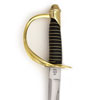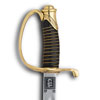|
|
|
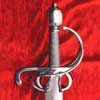 |
|
| Munich Sword Windlass |
Points: 15


|
Dating to around 1600, this German military cut-and-thrust sword with a swept hilt is a classic example of the type carried by the Munich Town Guard. Authentic examples of this sword can be found in prestigious collections such as the Wallace Collection and the Bavarian National Museum.
|
|
|
|
|
|
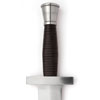 |
|
| Classic Hoplite Sword Windlass |
Points: 10


|
Dating back to the 5th century BC, the Greek Hoplite sword is a remarkable example of ancient weaponry. Greek Hoplites were renowned for their strength and effectiveness as citizen-soldiers, fiercely defending their city-states. The distinctive leaf-shaped blade of this sword, inspired by numerous archaeological finds and historical illustrations, was widely used across the ancient world.
|
|
|
|
|
|
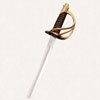 |
|
| Confederate Cavalry Saber Windlass |
Points: 10


|
This authentic, handmade replica features a flexible, ornate blade and a leather grip wrapped with brass wire. Of all Confederate swords and sabers, this was the most widely used. Wielded by troops under the command of J.E.B. Stuart, Wade Hampton, and Nathan Bedford Forrest, this saber dispatched hordes of Yankee soldiers.
|
|
|
|
|
|
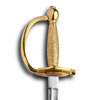 |
|
| 1840 Non Commissioned Sword Windlass |
Points: 10


|
The 1840 Non-Commissioned Officer (NCO) sword was carried by American soldiers for over 70 years, a period encompassing the Mexican War, the Civil War, and the Spanish-American War. The blade features a single, broad fuller running from the ricasso to near the point.
|
|
|
|
|
|
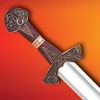 |
|
| Windlass The Suontaka Viking Sword |
Points: 12


|
Our stunning version of Suontaka Viking Sword features a highly detailed knot work pommel, guard, grip band and inserts. All have been lavishly plated in rich copper. The tough high carbon steel blade has a full tang and is fully tempered, then peened over the pommel.
|
|
|
|
|
|
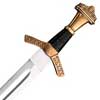 |
|
| Historical Excalibur Sword Windlass (500798s) |
Points: 10


|
This sword is of a type that was widely in use during this period and would be what a hard fitting warrior would prefer. Nicely balanced, well tempered high carbon steel sharp blade offset with antiqued brass parts.
|
|
|
|
|
|
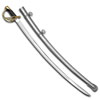 |
|
| Windlass Heavy Cavalry Saber 1840 (501150s) |
Points: 10


|
This historically accurate saber was well known as the “Wrist Breaker”. The model 1840 Cavalry Saber has a three branch brass guard, brass wire wrapped black leather grip.
|
|
|
|
|
|
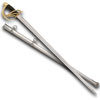 |
|
| French Napoleonic 1801 Cuirassier Sword Windlass (501866) |
Points: 10


|
French Model 1801 Cuirassier’s sword is a heavy cavalry saber with a straight blade, as the French favored the thrust over slashing or cutting. This replica weighs a little over 3 lbs, the substantial mass needed to accomplish a lance-type thrusting attack. The distally tapered blade is over 1/4” thick at the hilt and is double-fullered like the originals.
|
|
|
|
|
|
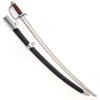 |
|
| American Revolution Saber Windlass (500872s) |
Points: 12


|
The handmade hilt of this American saber reflects their admiration of the 1700’s French style. This well-balanced, fast sword was designed for the mounted fighter. Solid steel hilt with spiral pattern carved hardwood grip is married to an effective 1085 high carbon, well tempered blade.
|
|
|
|
|
|
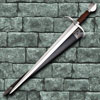 |
|
| Joinville Sword Windlass (501694s) |
Points: 12


|
The whole style of Joinville Sword is quite lovely, with elegant, simple lines that emphasize its deadliness. The sword has marvelous balance. The handle is polished hardwood with 2 brass ferrules.
|
|
|
|
|
|
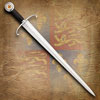 |
|
| King Henry V Sword Windlass (501780) |
Points: 20


|
King Henry V Sword was designed to be a superb weapon - simple, practical, and of high quality. The enormous, thick pommel looks misleadingly heavy, but is actually hollow. The raised rims on either side were brazed onto an inner iron disc. The recesses in the pommel were gilded with gold and accentuated with painted red crosses at the time of the king's funeral.
|
|
|
|
|
|
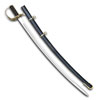 |
|
| Nasville Plow Cavalry Sabre Windlass (501152) |
Points: 12


|
This fine saber has a 1065 high carbon steel blade with full tang and is well tempered. A rare chance to own a unique piece of US wartime history. An authentic replica of the highest caliber. Prior to the Civil War Messrs. Sharp & Hamilton operated a farming implement company under the trade name of Nashville Plow Works..
|
|
|
|
|
|
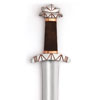 |
|
| Stiklestad Viking Sword Windlass |
Points: 12


|
Stiklestad Viking Sword is made of high carbon steel and is beautifully balanced and highly effective weapon. Capable of both cutting and thrusting, it is also a delight to the eye. Pommel and guard are tastefully decorated with copper. Leather covered wood grip.
|
|
|
|
|
|
|
|
Tags:
swords, swords, historical sword, historical swords, medieval sword, medieval swords, museum sword, museum swords, Godfred, viking, Saxon Scramasax, Sir William Marshall Sword, Roman Sword, Gladius, Edward III Sword, Hand-and-a-Half Sword, Scottish Claymore, Lowlander, Two-Handed Great Sword, Roman Dagger,
|




